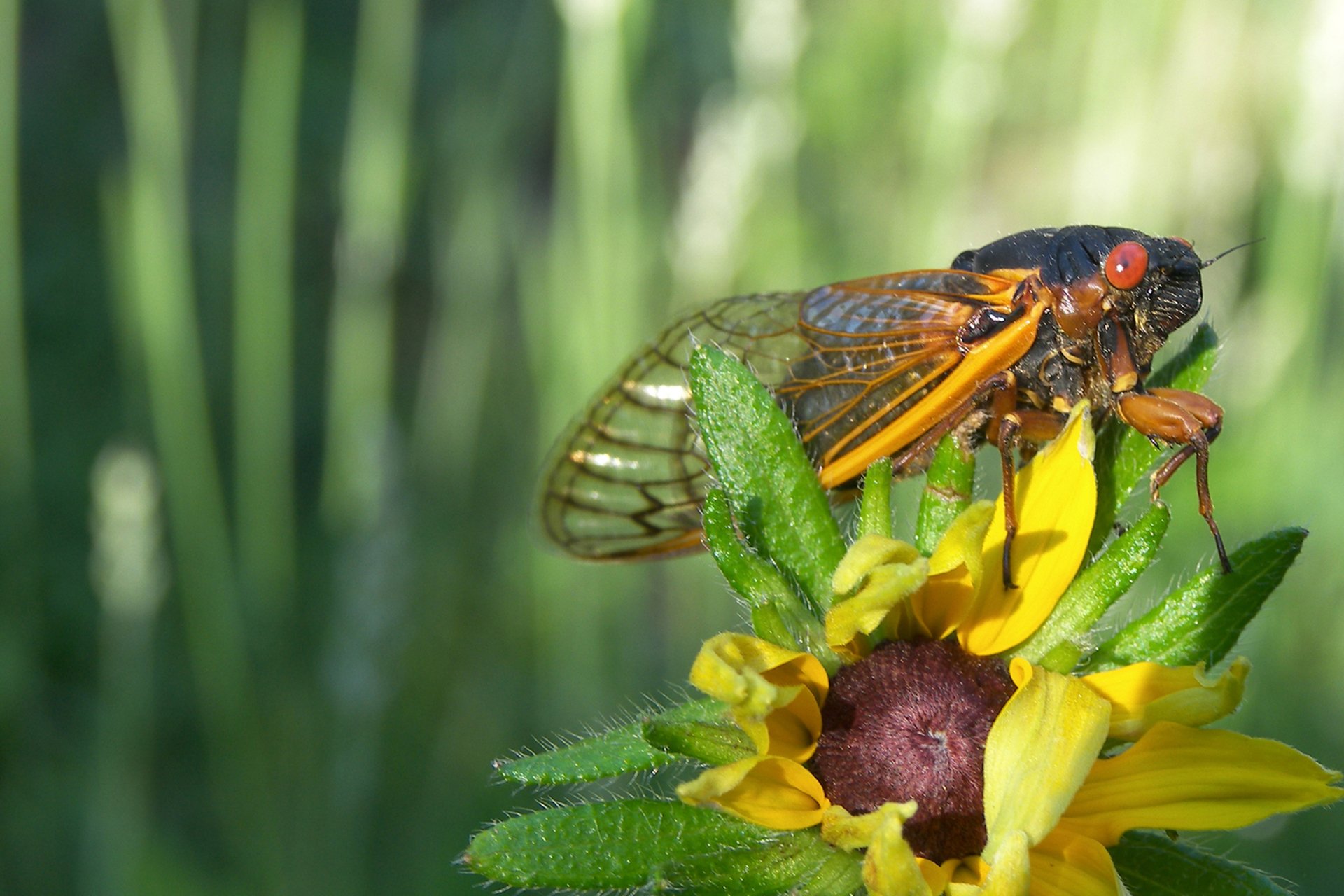Cicadas
Cicadas (sih-kay-duhs) comprise a family in the insect order Homoptera. This diverse group also contains leafhoppers, treehoppers, spittlebugs, aphids, and scale insects. More than 2,000 species of cicadas exist worldwide; nine species of cicadas have been documented from Massachusetts including one periodical cicada species, and eight annual cicada species. The most common in Massachusetts is the "Dog Day" Cicada (Tibicen linnei).
Identification
The annual or dog day cicada emerges every one or two years. It’s approximately 2.25 inches long, medium brown, with a green venation, the vein structure in its wing. Though we hear them each summer, these cicadas are solitary insects; we seldom see them.
The periodical cicada emerges once every 17 years. This smaller (1 to 1.5 inch) cicada is distinguishable by its black body, its more slender form, red eyes, and reddish-orange tinge on the wings. They often cover lower vegetation and any other surface in swarms immediately after they hatch.
Probably because of their regular population explosions, periodical cicadas have been confused with certain large grasshoppers that occur in crop-devastating swarms. It is these and other grasshoppers—not cicadas—that are properly called "locusts."
Life Cycle
Female cicadas make 40 to 50 slits in the twigs of broad-leafed trees, as well as weed and grass stems, in which to insert up to 400 eggs. The first stage nymph, which resembles a large, pale ant with front legs enlarged and modified for digging, hatches in six to seven weeks.
It then drops to the ground and buries itself two inches to two feet into the earth. This nymph lives by sucking juices from roots and grows gradually through eight stages before reaching maturity. The periodical cicada lives more than half of its 17-year lifespan as a mature nymph underground, and it is believed that dog day cicadas spend at least four years underground.
When the magic year arrives, the nymph digs to the surface, normally during the night, crawls up a tree trunk, and anchors itself with its claws. The skin of the back then splits, and the winged adult emerges and seeks its preferred habitat.
Singing
Cicadas are sometimes referred to as "harvester flies" because their "song" is characteristic of late summer days. This astonishingly loud sound comes from a pair of organs called "tympana" located at the base of the males' abdomen.
The tympana are complex mechanisms that consist of a series of three membranes inside a resonating chamber. A powerful muscle flexes one of these membranes (the tymbal), somewhat in the way we pull and release a metal, can top to create a loud click. Done in rapid succession and amplified by the resonating chamber, the familiar whine is produced. We can identify different species of cicadas by the distinctive tone of their hum.
Predators
Cicadas have many natural enemies, including birds, mites, fungal disease, and the cicada killer. This big black and yellow parasitic wasp catches and paralyzes its prey, then drags the victim into a subterranean burrow and uses it for an egg repository and as food for the larva.
Situations & Solutions
Probably because of their regular population explosions, periodical cicadas have been confused with certain large grasshoppers that occur in crop-devastating swarms. It is these and other grasshoppers—not cicadas—that we properly call “locusts.”
Cicadas are among the most benign of insects. They can buzz impressively when trapped, but they don't sting or bite, or carry any disease communicable to people.
Neither the root-sucking nymphs nor the adults do any significant damage to trees or other plants.
Because of their great abundance, when female periodical cicadas lay eggs in fruit and ornamental trees, they can sometimes cause the tips of branches to break. Some experts have suggested that shade and forest trees may actually benefit from cicada "damage," which acts, in effect, as a natural pruning mechanism.
If you’re concerned about small trees in your yard, protect them with netting or any other open-weave material during the adults' life span (five to six weeks).
Broods
Though some species are called annual cicadas because they present every year, all species take at least four years to mature in the ground. Among periodical cicadas, numerous different "broods" occur.
All periodical cicadas of the same life cycle (that emerge in the same year) are categorized into broods, or “year class.” Some broods are on 13-year cycles (in the south) and some on 17-year cycles (in the north). Each brood has its own unique range, population size, and emergence cycle.
There are 15 different broods in North America, two of which occur in New England. (Scientists have identified each brood and designated it with a Roman numeral.) Brood XIV, the one Governor Bradford recorded in 1624, may be the only one to occur in Massachusetts.
This brood extends from Plymouth and Bristol counties south to Georgia and west to Illinois. Writing of the 1923 emergence for the Bulletin of the Boston Society of Natural History, veterinarian Langdon Frothingham noted on June 25 that, "The air is full of them, often landing on you and singing in your ear."



